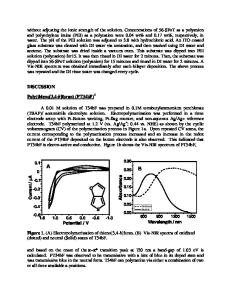Optically Active Polymers: A Systematic Study on Syntheses and Properties
Optically active materials are those which can easily rotate a beam of transmitted plane-polarized light into plane of polarization containing unequal amounts of corresponding enantiomers. The origin of optical activity is made in the chiral elements of a
- PDF / 3,039,981 Bytes
- 47 Pages / 439.37 x 666.142 pts Page_size
- 108 Downloads / 359 Views
1 Introduction Optically active materials are those which can easily rotate a beam of transmitted plane-polarized light into plane of polarization containing unequal amounts of corresponding enantiomers. The origin of optical activity is made in the chiral elements of a polymer such as centres or axes of chiral for long-range conformational order in a macromolecule. In fact, most naturally occurring macromolecules possess the ability to organize to more complex high structure rather than single one and manifest their functions. The problems of charged and reactive polymers are correlated to optically active compounds and it shows an inherent property of both ordinary macromolecules as well as large range of synthetic polymers. Chiral compounds are optically active and essential for life such as proteins, polysaccharides, nucleic acids, etc. and chirality is most important for existence. About 97 % drugs are formed from natural sources, 2 % are recemates and only 1 % is achiral, in looking of chirality of nearly 800 drugs. Optically active polymers today have also become of great interest and thus play a significant role in molecular assembly and arrangement, which is essential for super molecular structure of optoelectronics [1–4]. The synthetic optically active polymers may also play important role like mimicry of naturally occurring polymers and that’s why the extensive studies are required on their synthesis, conformations and properties. Various kinds of optically active polymers e.g., from its helicity, internal compounds nature, dendronization, copolymerization, side chromophoric groups, chiral, metal complex and stereo-specific behaviour are reported, however, those are not placed in a systematic manner. In the present book an effort has been made to collect most of those works in one place for better understanding in the subject with detailed explanation of properties like nonlinear optical properties of azo-polymers, thermal analysis, chiroptical properties, vapochromic behaviour, absorption and emission properties, thermosensitivity, chiral separation, fabrication and photochromism. © The Author(s) 2017 P.K. Dutta and V. Kumar, Optically Active Polymers, SpringerBriefs in Molecular Science, DOI 10.1007/978-981-10-2606-5_1
1
Optically Active Polymers: A Systematic Study on Syntheses …
2
– Classification of optically active polymers Optically active polymers are divided into three types: a. Biopolymers as obtained from nature. b. Polymers prepared by almost completely isotactic polymerization by modification of naturally occurring polymer backbones such as polysaccharides. c. Synthetic polymers as per the requirement with proper tailoring of functional groups. – Speciality of optically active polymer The properties of the optically active polymers are similar to other compounds except characteristics chain dimension and structural or conformational changes. Optically active polymers are very important due to its specific properties and attractive applications like creating of complex optical devices, enanti
Data Loading...










